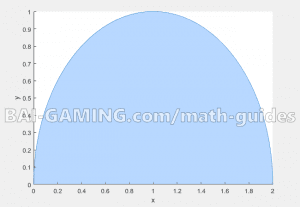Home»Math Guides»Double Iterated Integrals using Polar Coordinates (circular region of integration) example 2
Examples of Double Integrals in Polar Coordinates (Example 2)
How to use polar coordinates transformation to solve double integrals with circlular regions of integration – where radius is a function of theta
We want to find the value of the following definite integral by converting the double integral into polar coordinates.
You might not even be told to use polar coordinates on an exam question, it may just say “solve the integral”.
The key to knowing to use polar coordinate substitution is that you see terms that resemble the equation of a circle, or in other words, squared variable terms, specifically in the integral boundaries. They will look very distinctive compared to integral boundaries that are just regular numbers without equations.
Example problem: Find the integral \(\int_0^2 {\int\limits_0^{\sqrt {2 – {x^2}} } {\sqrt {{x^2} + {y^2}} dydx} } \)
The difference here is the upper integral limit, it looks a little unusual.
That’s because the region of integration is a shifted circle, not just a circle that has a center in the origin.
An easy trick to knowing the geometry of the circle is to just look at the other boundaries, notice that the integral for x goes from 0 to 2.
You don’t necessarily need to memorize all kinds of circle geometries or how shifted or stretched circles look! Don’t panic immediately if you don’t know what to do on an exam.
The boundaries will always match with the region of the circle, otherwise the problem wouldn’t make sense.
Lower boundaries will always be on the bottom of the integral, and the upper boundaries will always be on the top of the integral.
So you know that for this problem the region of integration is a circle that goes from x = 0 to x = 2, basically a semi-circle that’s only in the first quadrant.
In other words, notice that y goes from 0 to “some positive circle”, and that x goes from 0 to 2.
The only geometry that makes sense is a semicircle in the first quadrant! And we did that without knowing what that strange circle-looking equation in the integral boundary looked like!
We need to use substitution to convert this double integral to polar coordinates.
The upper boundary for y can be used, we square that to get a relation for the radius.
You can set that upper boundary, \(\sqrt {2x – {x^2}} \) is actually equal to y.
See the following steps:
\[\begin{array}{l}y = \sqrt {2x – {x^2}} \\{y^2} = 2x – {x^2}\\{x^2} + {y^2} = 2x\\{r^2} = 2x\\{r^2} = 2r\cos (\theta )\\r = 2\cos (\theta )\end{array}\]
So now that radius isn’t really a simple answer, it’s in terms of \(2\cos \left( \theta \right)\).
If you were to sketch this out, it’d look like:
If you want to plot a sketch of the region of integration above in MATLAB, use the following code (the circle goes from 0 to pi/2, radius of 2*cos(theta), and no shifting transformation, feel free to modify and use for other types of circles):
hold on
theta = 0:pi/100:pi/2
x = 2*cos(theta).*cos(theta) + 0;
y = 2*cos(theta).*sin(theta) + 0;
h = plot(x, y);
xlabel('x')
ylabel('y')
hold offThe reason the radius is a function of theta is because the circle was horizontally shifted, radius is only a clean number when the circle is centered at the origin.
So if it’s not immediately clear what the radius is, you may need to play around with a few trigonometric equations/relations.
So the radius goes from 0 to \(2\cos \left( \theta \right)\).
The circle is only in the first quadrant, and goes from x = 0 to 2.
So we need to include the entire first quadrant, meaning theta goes from 0 to \(\frac{\pi }{2}\)
Remember that each quadrant you go through, you need to add \(\frac{\pi }{2}\)
Don’t forget to add an extra “r” when you change to polar coordinates, and when you do the substitution you obtain:
\[\int_0^{\frac{\pi }{2}} {\int_0^{2\cos (\theta )} {r \cdot rdrd\theta } } \]
And we work through it as usual.
So do that inner integral first, and evaluate it at both boundaries.
You get 1/3 r cubed, and you evaluate it at both boundaries, and then you need to do the final integral.
\[\int_0^{\frac{\pi }{2}} {\frac{8}{3}} {\cos ^3}\left( \theta \right)d\theta \]
It’s an odd-powered cosine term.
Break then apart, and use a relation to simplify.
When you get a mixture or cosines and sines, then you can use substitution to easily solve.
\[\int_0^{\frac{\pi }{2}} {\frac{8}{3}} {\cos ^2}\left( \theta \right)\cos \left( \theta \right)d\theta \]
\[\frac{8}{3}\int_0^{\frac{\pi }{2}} {\left( {1 – {{\sin }^2}\left( \theta \right)} \right)} \cos \left( \theta \right)d\theta \]
Use regular substitution and solve.
Don’t forget, the integral boundaries will change when you use substitution!
Let \(u = \sin \left( \theta \right)\), then \(du = \cos \left( \theta \right)d\theta \), and solve as if it were a trig substitution integral problem.
You will get \(\frac{{16}}{9}\)
Try another example problem where you solve another double integral using polar coordinates!

